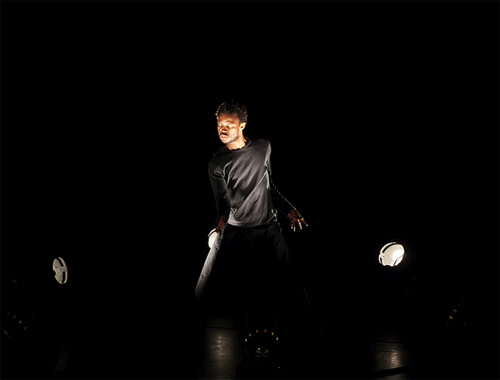TBA Day 10: Faustin Linyekula's Le Cargo Review

In his U.S. premiere of Le Cargo, Linyekula begins sitting on a carved stool, his small frame doubled, his knees knocked together. “I am a storyteller,” he says, “but I’m not here to tell stories, I’m here to dance.” Which isn’t entirely true, because he immediately begins to tell the story of how he lost his dance and went back to his childhood village to find it, touching on deeper themes of the meaning and value of story and dance (one tangible value being the money he could send home), as well as the effects of the "war, conflict, war, conflict" that has so deeply torn his country. His core body doesn’t move, but his arms rise and fall, his splayed fingers fluttering, grasping, and tapping at the air. And the story is captivating. Quite frankly, I could listen to Linyekula talk for hours, there is such beauty in his cadence, his words, and his tone.
But then he begins to dance. And sing. And it’s equally spare, unpretentious, and free—his fingers still fluttering—continuing his story through movement where his words end.
At one point, he dances in a small circle of lights sitting on the floor. As he glows golden in their luminance, the lights cast giant shadows on the walls, each dancing with him but at slightly different angles, creating the ritual dancers he never got to witness as a child but sought out as an adult.
During Nora Chipaumire's artist’s talk, she spoke about her desire to explore the shadow and darkness, which she identified as a color, that has long been attached to Africa by Westerners. She did so through cloaking her show in a darkness that was equally impenetrable, which made her performance inaccessible for a lot of us (although Robert Tyree and Rebecca Jacobson at WW perservered through the darkness). Linyekula, too, talks about the impenetrability of the African jungle (the train tracks to his hometown had to be cleared with machete), and he too dances with shadow and darkness that hinge on the conflicts and oppression of his homeland, but he does so in a way that illuminates the darkness while also embracing the shadow. It is certainly a more narrative, traditional performance, and thus somewhat unfair to compare because it is less challenging, but it moved me in a way that Chipaumire’s didn’t (which I acknowledge isn't the sole goal of art).
Similarly, his story and dance served as an interesting bookend to Miguel Gutierrez’s story and dance (read our review). Both, along with Laurie Anderson tomorrow night, fit one of the themes artistic director Angela Mattox is seeking to address: the singular artist’s point of view. Gutierrez tried to create a sense of authenticity by inviting the audience on stage, making his story seem off the cuff and unscripted, and lampooning the requirements of festivals, critics, and viewers that art have “meaning”—all the while giving his piece all the trappings of contemporary performance art—yet for me it felt like an artifice that distanced us more than drawing us in. Beyond saying hello to the audience at the beginning, Linyekula made no such pretense to deconstruct the theater he was sitting in, yet his piece and the questions it raised about the value of art and dance had a raw authenticity that we couldn’t help but diving into.
It’s always nice to be reminded that sometimes the simple but heartfelt and well executed is all we need.
The final performance of Le Cargo is tonight at the Winningstad Theater at 6:30pm.
